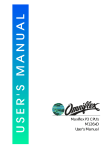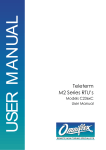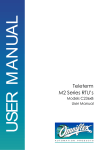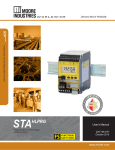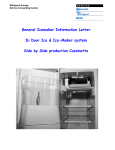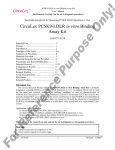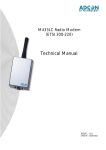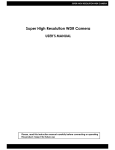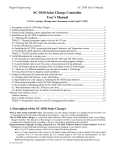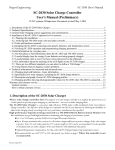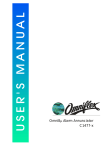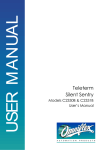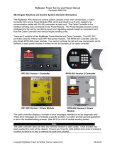Download M1589B HART NIM User Manual
Transcript
Maxiflex 8HI Hart Input Module M1438A SCOPE: The HART protocol is a comprehensive open communications standard for configuring and communicating with Smart field devices in industrial process applications. The Maxiflex M1438 8 Channel Hart Input Module is an Input Module that acts as a permanent host interface device (primary master) on up to eight Hart networks. The module is used to acquire data from the HART loops and to make the data available for SCADA, data-logging etc. in the Maxiflex system. Other specialised functions may be performed using the optional custom query block mechanism. This document describes the installation, set-up and use of the M1438A Hart module in a Maxiflex system. The reader is assumed to have a working knowledge of the Maxiflex system, and in particular the use of Data Interchange Table Registers (DIT’s) for the reading and writing of data in the module. UMM1438R1.pdf -2- Copyright Omniflex DATE March 2012 REVISION 1 COMMENTS Initial revision COPYRIGHT AND PROTECTIVE NOTICES 1. The Copyright of this document and the associated drawings, is the property of Omniflex and is issued on condition that it is not copied, reprinted or reproduced or transmitted in any form or by any means, electronically, photocopying, mechanical or otherwise, nor its contents disclosed, either wholly or in part, without the consent in writing of, or in accordance with the conditions of a contract with Omniflex. 2. The publication of information in the document does not imply freedom from patent or other protective rights of Omniflex or others. 3. Although every intention is made to ensure that performance figures and data are accurate the company reserves the right to alter without notice any product or specification. Performance figures and data must therefore be specifically confirmed by the company before they become applicable to any tender, order or contract. 4. In the case of electrical components, enough data is included in the drawings to allow maintenance of the equipment. However, if component availability or substitution information is required please consult the factory for assistance, as it is impossible to include data on every component in this document. 5. This product is sold without liability for consequential loss of any description. UMM1438R1.pdf -3- Copyright Omniflex Table of Contents 1. Introduction..........................................................................................................................5 2. Specifications ......................................................................................................................5 3. The HART Protocol .............................................................................................................7 Background to the HART Protocol...................................................................................7 Application of the HART Protocol ....................................................................................7 Technical Features of the HART Protocol .......................................................................7 The M1438- 8 Channel HART. ........................................................................................8 3.1 3.2 3.3 3.4 4. Installation ...........................................................................................................................9 4.1 Installing the 8HI on to a Maxiflex Base...........................................................................9 4.2 Connecting the HART Loops. ..........................................................................................9 4.3 Typical Connection Diagrams....................................................................................... 10 5. Built in Resistor................................................................................................................. 10 6. 6.1 6.2 6.3 6.4 6.5 6.6 Operation.......................................................................................................................... 11 Hart Loop Independence .............................................................................................. 11 Philosophy of Operation ............................................................................................... 11 LED Indication............................................................................................................... 12 Device Identification...................................................................................................... 12 Burst Mode Operation................................................................................................... 13 Priority Polling Operation .............................................................................................. 14 7.1 7.2 7.3 7.4 Configuration .................................................................................................................... 16 Basic Configuration....................................................................................................... 16 Configuring Custom Query Blocks................................................................................ 16 Automatic Polling / Burst Mode Configuration .............................................................. 18 Automatic/Manual Polling Configuration....................................................................... 19 7. 8. DIT Layout ........................................................................................................................ 20 8.1 Maxiflex Bus Interface Register Layout ........................................................................ 20 UMM1438R1.pdf -4- Copyright Omniflex 1. Introduction The M1438A Hart ® 8HI module is an intelligent I/O module in the Maxiflex range of products. The M1438 plugs into an I/O slot on a Maxiflex base and independently interrogates field devices on eight Hart networks, making the data available to the Maxiflex system. This data may be accessed by the entire range of Maxiflex CPU’s. The method of access may vary from CPU to CPU, and reference should be made to specific documentation for these products for details of the implementation. 2. Specifications Inputs/Outputs Number of HART loops 8 Number of Field devices interrogated 15 max per HART loop HART Operating Mode Primary Master or Secondary Master Loop Isolation Voltage 500V dc min. Maximum Loop Voltage 35Volts Minimum loop load resistance 230ohms Maximum loop load resistance 1100ohms HART Transmitter signal levels 400mV p-p min 600mV p-p max HART Receiver sensitivity 120mV p-p min 2000mV p-p max HART Receiver threshold (Must ignore) 80mV DC load impedance 2microamps max at 60deg C 40Volts AC load impedance 10 microFarads typical UMM1438R1.pdf -5- Copyright Omniflex HART Wiring Recommendations Maximum Cable Impedance R x C must be less than 65us (e.g. 300ohms x 0.2uF = 60us) (R includes load resistance) (C includes field device capacitance) Cable Type Overall screen recommended Individually screened pairs over 1500m Loop Power Supply Maximum Ripple 0.2V p-p (47-125Hz) Loop Power Supply Maximum Noise 1.2mV (500Hz – 10kHz) Loop Power Supply Impedance 10ohms Supported HART Commands as standard Universal Commands Command 0 Command 3 Identify Manufacturer, Device Type and Revision Levels. Read Current and four (predefined) dynamic variables. Other Commands User Configurable Up to 64 Custom Query Blocks may be configured in the 8HI. Each query block can address any HART device with any command support supported by that device. The response is stored in its raw data format in the Data Interchange Table for interpretation by the user. UMM1438R1.pdf -6- Copyright Omniflex 3. The HART Protocol 3.1 Background to the HART Protocol HART is an acronym for “Highway Addressable Remote Transducer”. The HART® protocol was originally developed by Rosemount Inc. but all rights in the protocol have now passed to the HART Communication Foundation, and the HART protocol is now freely available for general use. There is an abundance of information on the HART protocol available from a number of sources. The following Internet web-site is a recommended starting point for further reading: • The HART Communication Foundation at http://www.hartcomm.org 3.2 Application of the HART Protocol The HART protocol specifies a means for superimposing a digital messaging system on top of a conventional 4-20mA instrumentation loop to allow the remote interrogation and configuration of field devices. The operation of the HART system via the two wire 4-20mA loop does not affect the accuracy of the dc current in the loop. 3.3 Technical Features of the HART Protocol The HART protocol superimposes a Bell 202 Standard frequency-shift-keying signal at 1200 baud as an ac signal at a low level on the current loop. HART is a master/slave protocol. The field devices act as slaves in the protocol and only reply to requests addressed to them. Up to 15 slave devices may be connected on to a single pair of wires. In this multi-drop configuration, the field devices disable their 4-20mA signals and communication is exclusively via the HART protocol. When only a single slave device is present, then both the 4-20mA and HART communication may operate simultaneously. The protocol allows for two masters to be present on a single HART loop. These are typically a permanently connected control system (known as the primary master) and a hand-held configuration device known as a HART Communicator (acting as a secondary master). The command messages defined in the HART protocol are broken into three groups: 1. The “Universal” commands are implemented in all field devices. 2. The “Common-Practice” commands provide functions common to many field devices, but may not be installed in the device. 3. The “Device-Specific” commands provide functions that are unique to a particular manufacturer’s device. UMM1438R1.pdf -7- Copyright Omniflex The HART “Device Description Language” (DDL) is a formal language that allows a manufacturer to completely specify the communication interface to its HART equipped field device. This includes a definition of accessible variables, commands and operating procedures. It also includes a menu structure that a host device can use for a human operator. Device Descriptions make it easy to upgrade master devices to support new devices as they become available. 3.4 The M1438- 8 Channel HART. The M1438 8HI HART module is equipped with eight independent HART primary master interfaces. This allows this product to communicate independently with eight separate HART loops at the same time. The 8HI implements a subset of the universal commands and does not require DDL files to configure the device. The list of commands implemented is defined later in this document. The 8HI is designed to be self-configuring for ease of use. Once powered up, the 8HI searches for HART devices on each of its eight HART interfaces and builds an inventory of devices found. Various data elements are continuously and automatically read from the device and stored in the Data Interchange Table (DIT) in the device for access by the rest of the Maxiflex system. The 8HI in this mode uses HART commands 0 and 3 to extract the most commonly used data from the field devices with no configuration necessary. The 8HI is also provided with a custom query block mechanism. Up to 32 custom query blocks may be configured per loop to perform specialised data manipulation on the connected field devices using any of the command types supported by the field device. UMM1438R1.pdf -8- Copyright Omniflex 4. Installation 4.1 Installing the 8HI on to a Maxiflex Base. The M1438A 8HI must be inserted into one of the I/O positions of a Maxiflex Base. Refer to the Maxiflex bases General Instructions (PN 98-8952-930-XXX) for more detail on base layout, module insertion and module removal. Figure 1: Layout of the 7I/O Master Base 4.2 Connecting the HART Loops. Figure 2: Layout of the M1438 HART 8HI UMM1438R1.pdf -9- Copyright Omniflex Terminal-block connectors are provided for each HART interface. This interface is completely isolated from the 8HI circuitry and therefore will not affect the performance of a 4-20mA loop when connected. The connection is not symmetrical, and correct polarity must be observed in order not to affect the performance of the system. It is NOT recommended that this connection be made while the 4-20mA loop is active, as a small current upset may be observed when the 8HI circuit’s blocking capacitors charge. 4.3 Typical Connection Diagrams A B C Two Wire Transmitter Connection B C Four Wire Transmitter Connection The HART NIM may be connected across A-B or B-C 5. Built in Resistor Each Loop in the 8HI module has a built in 250 ohm 0.1% resistor. This resistor can be turned ON and OFF by configuration. The configuration can be found under Configuration- Loop Configuration- Loop n Configuration. The resistor can be turned ON and OFF by setting the “Resistor” item to ON or OFF. This resistor can be used to terminate the HART loop. UMM1438R1.pdf - 10 - Copyright Omniflex 6. Operation 6.1 Hart Loop Independence The 8HI operates eight completely independent polling procedures, one for each HART loop. The following description applies to any of these HART loops. 6.2 Philosophy of Operation In accordance with the Maxiflex inter-networking philosophy, the design of the M1438 8-Channel HART 8HI has been designed for maximum flexibility and ease of use. The HART 8HI is designed as an interrogation device to be used for the purpose of exchanging live plant data with a number of HART devices for data acquisition, monitoring and data-logging applications. The HART 8HI is not designed to replace the field device manufacturer’s recommended set-up tools or procedures. The configuration requirements for the 8HI have been kept to a minimum. In most applications, no configuration at all is required, because the 8HI automatically identifies the presence of field devices on the HART network, and begins polling for the most popular field device configuration and dynamic data. This data is automatically stored in the 8HI’s Data Interchange Table (DIT) from where it can be read by the rest of the Maxiflex system in the conventional manner. Upon power up, the 8HI begins an automatic polling sequence on each of the HART loops (using universal HART command 0), and identifies any devices present on the loops. The presence and identification of these field devices is made available in the DIT. Dynamic data is then read on a regular basis (using universal HART command 3) from these devices and is made available in the DIT. The 8HI continues to poll on a regular but infrequent basis for the presence of any additional field devices in the loop (using universal HART command 0), and automatically begins polling these devices (using universal HART command 3) when found. If a device is removed from the loop, then this is detected and the DIT updated accordingly. UMM1438R1.pdf - 11 - Copyright Omniflex 6.3 LED Indication Name 8HI OK Colour GREEN H1 – H8 GREEN Indication Steady ON - module healthy OFF or Flashing – module unhealthy (except on startup) Polled Mode Slow Flash: Polling for devices on the loop. No devices found yet. Steady ON: Healthy communication with all configured devices. Fast Flash: Communicating with devices on the loop but devices present does not equal configured devices. Burst Mode OFF: No communications present. Steady ON: Healthy communication from the configured device. Slow Flash: Receiving burst packets from a device not configured. Note that the 8HI module always polls for new devices. This means that the H1-H8 LED’s may flash continuously, even there are no devices connected to that loop. 6.4 Device Identification There is a possibility of up to 16 devices being present on a single HART loop. These devices are identified by their address in the range 0 to 15. (In normal operation it is not permitted to have all sixteen devices present at one time, but the 8HI is designed to cope with this error condition.) If a field device is configured for poll address 0 then it assumes it is the only HART device in the loop and its analogue current loop functions as a normal 4-20mA transmitter. If the HART loop is to be used in its multi-drop mode, then all HART field devices on that loop must be set to poll addresses in the range 1-15. If a HART device has its poll address set to anything other than 0 then its analogue output current is set to a constant 4mA. The 8HI reserves a space in the DIT for each address from 0 to 15. If a device is found, then the data from this device is stored in the DIT in the space reserved for its address. Each field device address slot can be in three states: • State 0: No device present • State 1: Revision 2,3 or 4 HART device present • State 2:Revision 5 HART device present The current state for each device address slot can be viewed in the DIT. The 8HI will periodically poll each slot in the “Device Not Present” state for a device being added. If a device is found then that slot is put into State 1 or 2 depending upon the type of device found. UMM1438R1.pdf - 12 - Copyright Omniflex The Revision level of each field device dictates how the 8HI addresses the device. HART Revision 5 devices have the facility to be addressed using a worldwide 5 byte unique identifier instead of the single byte address in the range 0 – 15. If the 8HI identifies a device as being Revision 5 or above, then this method of addressing is used for all other messages sent to the device. When the 8HI powers up, the entire DIT is cleared to 0 and all device slots are set to State 0 – No device present. The 8HI then searches for any present devices before entering its normal scan cycle. Part of this scan cycle entails periodically polling all address slots for a device to ensure that no devices are added later. This procedure ensures that within 60 seconds of any change in status, any device connected to the HART loop will have been identified and data will be valid. If polling of any present device fails 5 times in a row, then the device is returned to State 0 – device not present. 6.5 Burst Mode Operation 6.5.1 Introduction In Burst Mode operation there can only be a single slave per Loop. Burst Mode operation allows a single Slave to continuously send data to the Primary Master without the Master polling for the data hence improving data throughput. The Master will initiate Burst Mode once the User has selected Burst Mode operation in the Configuration and the Master has detected the presence of the Slave device. If the Slave has not been detected then the Master will revert to polled mode. 6.5.2 Master in Burst Mode and Slave in Polled Mode after Power on Reset The configuration in the HART 8HI is retained after a power on reset. Therefore if the Master was set to Burst and the Slave is in Polled Mode, then there will be no communication between the Master and the Slave until the Master is set to Polled Mode. Then if you recycle power the Master will start communicating with the Slave. At this point if you wish for the Slave to be in Burst Mode then you can configure the Slave by selecting Burst Mode in the configuration register for that Loop once the Master has detected the Slave in Polled Mode. 6.5.3 Master in Polled Mode and Slave in Burst Mode after Power on Reset If the Master was set to Polled mode and the Slave is in Burst mode then you will need to set the configuration to Burst Mode then recycle power to the Master, this will prevent the master from transmitting to the Slave which is already in Burst Mode. Now if you wish to switch the Slave to Polled Mode you can simply select Polled Mode in the configuration register for that Loop. 6.5.4 Master in Polled Mode and Slave in Polled Mode after Power on Reset If both the Master and the Slave are in Polled Mode then after a power on reset the Master will try to detect the Slave and once this has happened, then the Master will get the data from the Slave and store it in the Loop Dynamic Data- Loop n- Device x, n is the loop number (1to8) and x is the ID of the Slave when in Polled Mode. UMM1438R1.pdf - 13 - Copyright Omniflex Refer to the GROUP Loop Dynamic Data and the item Loop n Devices Present to determine where to find the Dynamic data for that Slave. 6.5.5 6.6 Master in Burst Mode and Slave in Burst Mode after Power on Reset If both the Master and Slave are in Burst Mode after a power on reset then the Slave's Dynamic data will be stored in Loop n - Device 0 Data GROUP in Omniset, where n is the Loop number to which the slave is connected. If you wish to switch the Slave to Polled Mode you can simply select Polled Mode in the configuration for that Loop and write it to the target. The Dynamic Data for the Slave will no longer appear in Loop n - Device 0 Data but will rather appear in the GROUP pointed to by the Slave ID. Refer to the GROUP Loop Dynamic Data and the item Loop n Devices Present to determine where to find the Dynamic data for that Slave. Priority Polling Operation 6.6.1 Introduction This feature allows the User to prioritise the rate at which the transmitters are polled by the Master. This is done using Configurable Transmitter Polling Rates. These configurable timers will allow the User to adjust the rate of polling of each device on each loop as per the User's requirements to allow the User to customise the data throughput. The User can switch between Manual and Automatic mode of Operation. Manual mode uses the Configurable Timers to decide whether to poll the transmitter or not also how often to poll the transmitter. In automatic mode all transmitters are polled at the same rate and the Poll Timer Configuration is ignored. 6.6.2 Automatic Polling When automatic polling is selected for the loop, all transmitters are polled at the same rate. After every 7 cycles of polling, the Master will search for a device which is not Online. If the device is found then it will be switched to Online. When Automatic polling is selected the Programmable Poll Timers for each loop are ignored. 6.6.3 Manual Polling When Manual polling is selected for the loop, all transmitters connected to the loops are polled according to the Poll Timer setting rate. If the Poll Timer is set to “Do Not Poll” then that slave device will be ignored by the polling engine. The User can select from a range of polling rates which range from “As fast as Possible” to “5 seconds” per device. The polling engine will only search for Offline devices that have their poll timers configured. 6.6.4 Inhibit Polling In specialized applications where the two HART 8HI modules are used in a redundant switch over configuration, two HART 8HIs are connected to the same loop. One module is the active module whilst the other is in standby, ready to be made active if the active module becomes faulty. In order to operate this way, it is UMM1438R1.pdf - 14 - Copyright Omniflex necessary to inhibit the transmitter of the standby 8HI module so as not to cause conflict on the current loop. A special Dynamic DIT register (Loop Dynamic Data – Loop Inhibit) is used for this purpose, where a single bit is used to control the transmitter of each port. These bits are to be controlled by Maxiflex CPU program only and are always cleared on startup i.e. transmitter always enabled. Refer to the DIT layout for more details. UMM1438R1.pdf - 15 - Copyright Omniflex 7. Configuration 7.1 Basic Configuration No configuration is necessary for the 8HI to operate in its basic polling state. Once connected and powered up, the 8HI automatically begins polling all addresses on the HART loop identifying any HART field devices present on the loop. The 8HI then reads the specified data from the device and stores it in the DIT to be accessed by the Maxiflex CPU in the system. It can take up to 60 seconds after power up for the data to become valid in the DIT. The validity of data may be checked by monitoring the Loop Dynamic Data – Loop n Devices Present DITs. These registers identify the presence of valid data for field devices by setting the corresponding bits in the DIT. If the bit is clear, then the data in the DIT for that device is not valid. The layout of the DIT is shown in section 8. 7.2 Configuring Custom Query Blocks 7.2.1 Introduction The user can configure up to 32 Custom Query Blocks per loop in the 8HI. Each query block can contain any valid HART command and can address any device on either of the HART loops. Each Query Block can be configured as a “one-shot” query that is triggered by the user, or can be configured as a “cyclic” query where the Query is triggered on a regular basis by the 8HI. The status of each Query is presented in the Loop Dynamic Data - Query Status DIT registers. These registers indicate the success or failure of each query last time it was sent. 7.2.2 Polling Sequence As described above, the 8HI automatically identifies all field devices present on each HART loop and polls each present device in turn using HART command 3. After the Command 3 sequences to all present devices have been completed, all Custom Query Blocks ready to execute are then triggered in turn. The 8HI then returns to execute the command 3 queries to all present devices, and the cycle repeats. This is known as a complete polling sequence. 7.2.3 Configuring Queries Queries are configured by setting up the Query Block. This query block can be found under Configuration- Query Configuration- Loop n- Queries 1-32. Each Query Block consists of 5 DIT registers which will be described below. 7.2.4 Controlling the Execution of a Custom Query Block Each Custom Query Block has a Control Register (Cyclic Polling Register) used to control the Query Block. If this register is set to 0 then the query block is disabled. UMM1438R1.pdf - 16 - Copyright Omniflex If a value “n” between 1 and 255 is stored into this register then the Query block acts as cyclic query, and the Query is triggered every “n” number of polling sequences. To use the query as a one shot (sent once on command), set the control register (Cyclic polling register) to zero and use the one shot query trigger bits (Loop Dynamic Data- One Shot Query Triggers) to initiate it. 7.2.5 Setting the device to be addressed by a Custom Query Block The least significant byte of the Hart Device Address register holds the polling address of the field device to be polled using this query block. If the device is a HART revision 5 device, then the 8HI will use the device’s corresponding unique identifier to address it in this Query Block provided the device is currently online. 7.2.6 Setting the command type in a Custom Query Block For each Query Block, the HART command to be used is specified in the third register of the query block (HART Command) along with two other items. The Command is a single byte number in the range 0 to 153 as specified by the HART protocol. The command to be used in this query block must be stored in the least significant byte of this DIT register. 7.2.7 Setting the Data to be transmitted in a query Some HART commands require that data be included in the message transmitted to the field device. Store the number of bytes to be transmitted in the most significant byte of the third DIT register (HART Byte Count) in the query block. This is a count of the number of actual data bytes to be transmitted and excludes any header information and checksum in the transmitted message. The HART protocol specified that this count is limited to 25 bytes of data. If there is no data associated with the command then this byte count must be set to 0. If this data is to be changed dynamically by the user then store the actual data bytes to be transmitted under Query Status – Loop n Query Data. These DITS are packed 2 bytes per register, starting in the least significant byte position of the first register. Store the DIT start address of the data in the fourth register in the Query Block (Data Source DIT Address). NB: Do not use one Loop’s dynamic Query Data block with another loop. Care should be taken in the allocation of DIT space for this data to avoid overwriting other data inadvertently. 7.2.8 UMM1438R1.pdf Setting the destination of the received data from a Query Block. Some HART commands return data as part of the reply. This data will be written to the DIT in an area specified in the query block. Again the Dynamic area provided under Query Status – Loop n Query Data should be used. NB: Do not use one Loop’s dynamic Query Data block with another loop. - 17 - Copyright Omniflex Store the DIT address where you wish the start of the returned data to be written in the fifth register in the Query Block (Data Destination DIT Address). By default, the data will be written packed two bytes to a register, however it is possible to format the way in which the data is stored as explained in the next two sections. 7.2.9 Setting an offset to the start of response data. Many HART response messages have a mixture of single byte and multi-byte data. As a result, it is sometimes convenient to start storing the returned data in the most significant byte of the first DIT register. This will allow multi-byte data later in the message to be conveniently contained in a one or two DIT registers instead of split across DIT Register boundaries. This can be achieved by setting the Receive Data Offset Bit which is the most significant bit of the third Query Block register (Offset Receive Data register) (sharing space with the byte count and command type). Set this bit to start the returned data storage in the most significant byte of the first register. The least significant byte will then be set to zero. Clear this bit to start the data storage in the least significant byte of the first DIT register. 7.2.10 Specifying a format for response data. Where further formatting of the response data is required, use can be made of the response formatting blocks. These blocks facilitate the specification of the exact order and position that every byte in the response is stored in the DIT. Each block consists of 25 registers to cater for the maximum of 25 bytes in a HART response. Each register in a block can be configured to specify the byte number (data) from the response that should be stored in either the least or most significant byte of the corresponding DIT register. Up to 16 such format blocks may be configured per loop, and any number of queries may reference a single format block. Note that a query that uses a format block, will ignore the receive data offset setting as described in the previous section. 7.3 Automatic Polling / Burst Mode Configuration To configure a Loop for Burst Mode or Polled Mode operation select the static GROUP Configuration- Loop Configuration- Loop n Configuration and set the Loop n Burst Mode Control to either “Polled Mode” or “Burst Mode”. Refer to Section 8 DIT Layout for the DIT address of these configuration items. UMM1438R1.pdf - 18 - Copyright Omniflex 7.4 Automatic/Manual Polling Configuration 7.4.1 Automatic Polling To configure a Loop for Automatic or Manual Polling operation select the static GROUP Configuration- Loop Configuration- Loop n Configuration and set the Polling Method Loop n to either “Automatic Polling” or “Manual Polling”. 7.4.2 Manual Polling If Manual Polling is selected, then the device timer also needs to be configured. This is done under Configuration- Loop Configuration- Loop n Configuration by setting Device x Timer Config. The setting can be selected from the drop down menu. The following options are available: “Do Not Poll”, “1 Second”, “2 Seconds”, “3 Seconds”, “4 Seconds”, “5 Seconds”. UMM1438R1.pdf - 19 - Copyright Omniflex 8. DIT Layout 8.1 Maxiflex Bus Interface Register Layout The HART 8HI Module is an intelligent module with a standard “Network Interface Module Revision 2” internal interface. This implies that this module is not scanned by the CPU as regular I/O. (This is due to the large number of interface registers required by this module). This module has its own Data Interchange Table (DIT) of 20000 registers that are accessible from the User Program in the CPU. The following Module DIT registers are defined: 8.1.1 Module Identification and Status DIT No. Description 0 – 23 Product Information 0 Product Code Type RO Unique Number in BCD format that reflects the type of product as follows: 0405 – M1438A 1 DIT Revision Number RO Version Number of the DIT Layout supported by the Module. 2 Kernel Version Number RO Version number of the CPU Kernel in BCD format. 3 Supported Services Flags RO Network related services supported by the module Kernel: Bit 0: DIT service =1 Bit 1: Subscription service = 1 Bit 2: Queue service = 0 Bit 3: Datagram service = 0 Bit 4: Routing service = 0 Bit 5: Reserved = 0 Bit 6: Forth Programming service = 0 Bit 7: ISaGraf Programming Service = 0 Bits 8-15: Reserved = 0 Bits set indicate which service is supported. 4-7 Tag Name R/W User configurable string of DIT registers in ASCII format. The user is able to write up to 8 ASCII characters into these DIT registers (two characters per register) to uniquely identify the module. This Tag Name is used by OMNISET to verify that the correct module is being communicated with. This Tag Name must match the Tag Name set in OMNISET to allow the configuration to be changed. 8 Configuration Version R/W BCD number representing the current version of the User’s Configuration. UMM1438R1.pdf - 20 - Copyright Omniflex DIT No. Description Type The two most significant digits represent the major revision number, and the two least significant digits represent the minor revision number e.g. Revision 02.01 This number is maintained by the user, and is used to assist the user to manage configuration changes in the product. (See Omniset Configuration Management) 9 Configuration Revision R/W This is an integer representing the revision number of the current configuration version. This number is maintained by the user, and is used to assist the user to manage configuration changes in the product. Omniset automatically increments this register if a change is made to the module from Omniset (See Omniset Configuration Management) 10-22 RESERVED 23 Alive Counter R/W Free running counter in the module. Useful for communications diagnostics. This register increments continuously while the software kernel is operational. If this register stops changing, then the module is not operational or communications to the module has failed. 24 – 49 UMM1438R1.pdf Reserved - 21 - Copyright Omniflex 8.1.2 General Module Status and Control DIT No. Description 1050-1053 HART 8HI LOOP DYNAMIC DATA 1050 Loop 1 Devices Present 1051 Loop 1 Good Message Counter 1052 Loop 1 Error Message Counter 1053 Loop 1 Last Good Message Timer 1054-1085 DEVICE STATUS AND COMMAND RESPONSE 1054 Loop 1 Device 0 Communication /Device Status 1055 Loop 1 Device 0 Command Response … … (device 1-14) 1084 Loop 1 Device 15 Communication /Device Status 1085 Loop 1 Device 15 Command Response 1086-1469 HART LOOP 1 DYNAMIC DATA 1086 – 1109 Loop 1 Device 0 STATIC DATA 1086 Transmitter Type Code 1087 Manufacturer’s Identification Code in High Byte; Manufacturer’s Device Type Code in Low Byte 1088 Number of Preambles Required 1089 Universal Command Revision in High Byte; Device Specific Command Revision in Low Byte. 1090 Software Revision in High Byte; Hardware Revision in Low Byte. 1091 Device Function Flags in High Byte; First Byte of Final Assembly Number/ID Number in Low Byte. 1092 Second Byte of Final Assembly Number/ID Number in Hi Byte; Third Byte of Final Assembly Number/ID Number in Low Byte. 1093 Common Practice Command Revision in High Byte; Common Tables Revision in Low Byte. UMM1438R1.pdf - 22 - Copyright Omniflex DIT No. 1094 Description Data Link Revision in High Byte; Device Family Code in Low Byte. 1095 Reserved DYNAMIC DATA UMM1438R1.pdf 1096 – 1097 Current (mA) 1098 Primary Variable Units Code 1099 – 1100 Primary Variable Value 1101 Second Variable Units Code 1102 – 1103 Second Variable Value 1104 Third Variable Units Code 1105 – 1106 Third Variable Value 1107 Fourth Variable Units Code 1108 – 1109 Fourth Variable Value 1110 – 1033 Loop 1 Device 1 --- --- 1446 – 1469 Loop 1 Device 15 1470 HART LOOP 1 INHIBIT 1470 Inhibit Loop 1 1471-1988 HART LOOP 1 Query Status 1471 Query 1 to 16 Status 1472 Query 17 to 32 Status 1473 Query 1 Communication / Device Status 1474 Query 1 Command Response … ... 1535 Query 32 Communication / Device Status 1536 Query 32 Command Response 1537 Queries 1 to 16 One Shot Triggers 1538 Queries 17 to 32 One Shot Triggers 1539-1988 User Query Data - 23 - Copyright Omniflex DIT No. 2050 – 2988 HART LOOP 2 DYNAMIC DATA 3050 – 3988 HART LOOP 3 DYNAMIC DATA 4050 – 4988 HART LOOP 4 DYNAMIC DATA 5050 – 5988 HART LOOP 5 DYNAMIC DATA 6050 – 6988 HART LOOP 6 DYNAMIC DATA 7050 – 7988 HART LOOP 7 DYNAMIC DATA 8050 – 8988 HART LOOP 8 DYNAMIC DATA 31000 31981 LOOP 1 NON-VOLATILE CONFIGURATION DATA AREA 31000 Burst Mode Configuration 31000 Loop 1 Burst Mode Control 31001 – 31016 UMM1438R1.pdf Description Poll Timers Configuration 31001 Device 0 Timer Configuration … … 31016 Device 15 Timer Configuration 31017 31176 Loop 1 Query configuration 31017 Start DIT Register for Query Response Codes 31018 Message Retry Count - 24 - Copyright Omniflex DIT No. UMM1438R1.pdf Description 31019 31023 Loop 1 Custom Query Block No. 1 31019 Query Block Control Register 31020 Format Block / HART Device Address 31021 Count/Command Register 31022 Transmitted Data Address 31023 Received Data Address 31024 31028 Loop 1 Custom Query Block No. 2 --- --- 31174 – 31178 Loop 1 Custom Query Block No. 32 31179-31578 QUERY FORMAT BLOCKS 1 TO 16 31179 31203 Query Format Block No. 1 --- --- 31554 31578 Query Format Block No. 16 31579-31979 General User Non-Volatile Area 31980 Loop 1 Resistor Control 31981 Loop 1 Device Configuration 31981-31999 Reserved 32000 – 32999 HART LOOP 2 CONFIGURATION DATA 33000 – 33999 HART LOOP 3 CONFIGURATION DATA - 25 - Copyright Omniflex DIT No. UMM1438R1.pdf Description 34000 – 34999 HART LOOP 4 CONFIGURATION DATA 35000 – 35999 HART LOOP 5 CONFIGURATION DATA 36000 – 36999 HART LOOP 6 CONFIGURATION DATA 37000 – 37999 HART LOOP 7 CONFIGURATION DATA 38000 – 38999 HART LOOP 8 CONFIGURATION DATA - 26 - Copyright Omniflex




























